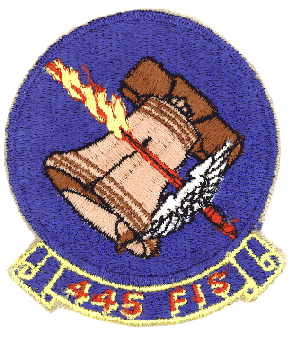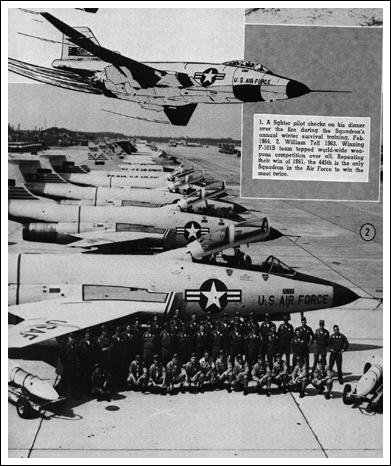 |
445th Fighter Interceptor Squadron Insignia
|
Station
|
|
|
Wurtsmith Air Force Base
|
18 Aug 1955
|
|
Deactivated
|
30 Sept 1968
|
Assignment
|
|
|
412th Fighter Group
|
18 Aug 1955
|
|
Sault Ste Marie Air Defense Sector
|
1 Apr 1960
|
|
Deactivated
|
30 Sept 1968
|
Aircraft
|
|
|
Northrup F-89D Scorpion
|
18 Aug 1955
|
|
Northrup F-89H Scorpion
|
Mar 1956
|
|
Northrup F-89J Scorpion
|
Late 1956
|
|
McDonnell F-101B Voodoo
|
Dec 1959
|
|
Deactivated
|
30 Sept 1968
|
Tactical Call Sign
|
|
|
Tiptoe
|
1957 - 1960
|
History of the 445th Fighter Interceptor Squadron
The 445th Fighter Squadron (Special) was constituted on 19 February 1943 and
was activated at the Army Air Forces Tactical Center, Orlando, Florida, on 24
February 1943. During 1943 and 1944, when the squadron was first at Orlando and
later at Leesburg, Florida, the 445th was assigned as many as fifty-seven
airplanes and experimented with thirteen types of aircraft.
The 445th Fighter Squadron was transferred, less personnel and equipment, to
the Material Command Flight Test Base, Muroc, California, on 18 March 1944, and
assigned to the 412th Fighter Group (Single Engine). The initial assignment of
new personnel was made on 1 April 1944. During the next two months pilots and
maintenance personnel trained on the P-59A, the Army Air Force's first
jet-propelled aircraft. The 445th moved from its temporary base at Muroc,
California, to Palmdale Army Air Field, Santa Maria, California, on 10 July
1945.
The 445th Squadron was inactivated on 3 July 1946, at March Field,
California, and its personnel and equipment were absorbed by the 71st Fighter
Squadron.
The unit redesignated 445th Fighter Interceptor Squadron on 11 February 1953,
was activated on 20 March 1953, at Geiger Field Spokane, Washington. One T-33
was assigned to the unit on 9 June 1953. Later in the year F-86D's were
added.
At the end of September, the 445th had the honor of being selected top
squadron in the Western Air Defense Force. Its flying time was the highest in
the 25th Air Division. Its scramble-to-airborne time was the lowest (4.5
minutes), and its turn-around time on a mission was the fastest (12 minutes) in
the Western Air Defense Force. In addition it had the highest percent (83) of
combat crew ready in the Western Air Defense Force.
 |
| 445th FIS F101 Voodoos |
In November 1954, the 445th went to Yuma County Municipal Airport, Arizona,
for annual rocket training. When the firing was over, the unit had broken all
existing Air Defense Command records in air-to-air rocketry. The 445th, less
personnel and equipment, was transferred to Wurtsmith Air Force Base, Oscoda,
Michigan, on 18 August 1955. At the end of August the 445th was sent to Moody
Air Force Base, Georgia, for annual rocketry training. The unit was now using
F-89D's and carrying out the training requirements of the Eastern Air Defense
Force.
Early in 1956, the 445th Fighter Interceptor Squadron, under the command of
Lieutenant Colonel Weston M. Lennox, again went into a transition period, this
time with the F-89H. In March of 1957, with the conversion to the F-89J, the
unit became one of the first squadrons to have a nuclear capability. In July of
1958, Lieutenant Colonel M. C. Morphew Jr. assumed command of the 445th and in
February of 1959, deployed the unit to Yuma, Arizona, for weapons training. At
Yuma in 1959, the 445th broke all existing records for the aircrew written
tactical evaluation examination and placed second in both "dry" and "wet"
firing.
The 445th received the first part of its full complement of F-101B's in
December 1959 and in August 1960, Lieutenant Colonel Morphew led the first
flight of six F-101B's to the weapons training center at Tyndall AFB, Florida,
for weapons training and firing.
In July 1961, Lieutenant Colonel Sam C. Wilkerson, Jr. assumed command of the
445th in October 1961, Lieutenant Colonel Wilkerson led a flight of four
F-101B's to Tyndall AFB, Florida to compete in the United States Air Force's
"William Tell" World Wide Fighter Interceptor Weapons Meet. The 445th was
selected, on a competitive basis, to represent the 30th Air Division (SAGE), in
Category I competition and in a thrilling extra-mission shoot-off, the 445th won
first place.
On 28, June 1962, Lieutenant Colonel Wilkerson and Lieutenant John Felbinger
were killed in and F-101 accident. Shortly there after, Lieutenant Colonel
William E. Shelton assumed command.
The 445th FIS enhanced its fine record in 1963 by winning several difficult
competitive flying and armament loading events in preparation for the "William
Tell 1963." Newly integrated into the 26th Air Division, the 445th won the Air
Defense Sector flying and armament loading competitions for the F-101B. In the
next round of competition during "Project Fairway," the 445th vied with five
other top F-101B squadrons from the 26th Air Division and this unit won first
place honors again. In the most trying of all Air Defense Command competitive
events, "William Tell 1963," the 445th FIS became the first organization to win
"William Tell" twice with the armament loading crew taking over-all world-wide
honors.
In 1964 the 445th FIS, while still in the recovery phase of the F101B and
MCSL modifications, was rated satisfactory during an ADC no-notice operational
readiness inspection of the Detroit Air Defense Sector and a satisfactory rating
during concurrent capability inspection.
The Planes That Made Their Mark with the 445th FIS at Wurtsmith A.F.B.
P59-A "Airacomet"
Development of the P-59, America's first jet propelled airplane, was ordered
personally by General H.H. Arnold on September 4, 1941. The project was
conducted under the utmost secrecy, with Bell building the airplane and General
Electric the engine. the first P-59 was completed in mid-1942 and on October 1,
1942, it made its initial flight at Muroc Dry Lake (now Edwards Air Force Base),
California. One year later, the airplane was ordered into production, to be
powered by I-14 and I-16 engines, improved versions of the original 1-A.
Bell produced 66 P-59s. Although the airplane's performance was not
spectacular and it never got into combat, the P-59 provided training for AAF
personnel and invaluable data for subsequent development of higher performance
jet airplanes.
T-33 "Shooting Star"
The two-place T-33 jet was designed for training pilots already to fly
propeller-driven aircraft. It was developed from the single-seat F-80 fighter by
lengthening the fuselage slightly more than three feet to accommodate a second
cockpit.
Originally designated the TF-80C, the T-33 made its first flight in March
1948. Production continued until August 1959 with 5,691 T-33s built. In addition
to its use as a trainer, the T-33 has been used for such tasks as drone director
and target towing, and in some countries even as a combat aircraft.
The RT-33A version, reconnaissance aircraft produced primarily for use by
foreign countries, have a camera installed in the nose and additional equipment
in the rear cockpit.
The T-33 is one of world's best known aircraft, having served with the air
forces of more then 20 different countries for almost 40 years. Many are still
in use throughout the world.
F-86D "Saber"
The F-86D made its first flight on December 22, 1949. It was developed as an
all-weather interceptor version of the famed F-86A, the airplane that won
supremacy of the skies from the Mig 15 during the Korean Conflict. The F-86D was
used during the 1950's-both in the US. and overseas-to guard against possible
air attack. In all 2,506-Ds were produced
The F-86D was known for two historic firsts. It was the first USAF airplane,
to have a rocket armament, and the first all-weather interceptor to carry only
one person for operating radar fire control system as well as piloting the
airplane. It also had the unique distinction of succeeding itself in setting a
new world's speed record-698.505 mph on November 19, 1952 and 715.697 mph on
July 16, 1953.
F-101B "Voodoo"
The F-101 originally was designed as a long-range Bomber escort for the
Strategic Air Command. However, when high-speed, high-altitude jet bombers such
as the B-52 entered active service, escort fighters were not needed. Therefore,
before production began the F-101's design was changed to fill both tactical and
air defense roles.
The F-101 made its first flight on Sept. 29, 1954.
The first production F-101A became operational in May 1957, followed by the
F-101C in Sept. 1957 and McDonnell had built 785 Voodoos including 480 F-101Bs.
the two-seat all-weather interceptor used by the Air Defense Command.
In reconnaissance versions, the Voodoo was the world's first supersonic
photo-recon aircraft.
These F-101's were used widely for low-altitude photo coverage of missile
sites during 1962 Cuban Crisis and during late 1960s in Southeast Asia.
(Contributed by: S/Sgt Gilbert Fisceri (Ret) - Assigned to WAFB 1961 to
1965)